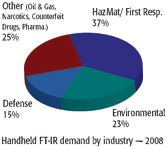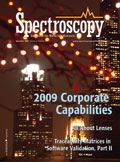Market Profile: Handheld and Portable FT-IR
The handheld and portable Fourier-transform infrared (FT-IR) market is a very new and rapidly growing market thanks to the intersection of technological advancements and new demand. Relative to other portable analytical technologies, the range of applications for the technology is more diverse. Despite the rapid growth and potential for this market, however, only a handful of competitors currently dominate the market.
Market Profile: Handheld and Portable FT-IR
The handheld and portable Fourier-transform infrared (FT-IR) market is a very new and rapidly growing market thanks to the intersection of technological advancements and new demand. Relative to other portable analytical technologies, the range of applications for the technology is more diverse. Despite the rapid growth and potential for this market, however, only a handful of competitors currently dominate the market.

Handheld FT-IR demand by industry - 2008
Like laboratory infrared spectroscopy, nearly all portable and handheld infrared instruments are now based upon FT-IR configurations. Technological improvements in areas such as optics and batteries have now reached the point of allowing for compact, portable FT-IR instruments that in some cases have the same performance as some benchtop laboratory instruments.
Portable and handheld FT-IR instruments offer a combination of cost and performance that is not available in other portable analytical methods, such as mass spectrometry, ion mobility spectroscopy, and sensor arrays. In addition, FT-IR is capable of both liquid and gas phase analyses. Such advantages have made portable and handheld FT-IR popular among HazMat crews and other first responders, for in-field environmental analyses, for defense and security applications, and others.
Smiths Detection has been the early leader in this market, but is now being challenged by the rapidly growing business of Ahura Scientific, which recently entered the market. The 2008 market for portable and handheld FT-IR was around $50 million and is forecast to break $90 million by 2013.
The foregoing data were based upon SDi's market analysis and perspectives report entitled Global Assessment Report, 10th Edition: The Laboratory Life Science and Analytical Instrument Industry, September 2008. For more information, contact Stuart Press, Vice President — Strategic Analysis, Strategic Directions International, Inc., 6242 Westchester Parkway, Suite 100, Los Angeles, CA 90045, (310) 641-4982, fax: (310) 641-8851, www.strategic-directions.com.
AI Shakes Up Spectroscopy as New Tools Reveal the Secret Life of Molecules
April 14th 2025A leading-edge review led by researchers at Oak Ridge National Laboratory and MIT explores how artificial intelligence is revolutionizing the study of molecular vibrations and phonon dynamics. From infrared and Raman spectroscopy to neutron and X-ray scattering, AI is transforming how scientists interpret vibrational spectra and predict material behaviors.
Real-Time Battery Health Tracking Using Fiber-Optic Sensors
April 9th 2025A new study by researchers from Palo Alto Research Center (PARC, a Xerox Company) and LG Chem Power presents a novel method for real-time battery monitoring using embedded fiber-optic sensors. This approach enhances state-of-charge (SOC) and state-of-health (SOH) estimations, potentially improving the efficiency and lifespan of lithium-ion batteries in electric vehicles (xEVs).
New Study Provides Insights into Chiral Smectic Phases
March 31st 2025Researchers from the Institute of Nuclear Physics Polish Academy of Sciences have unveiled new insights into the molecular arrangement of the 7HH6 compound’s smectic phases using X-ray diffraction (XRD) and infrared (IR) spectroscopy.
